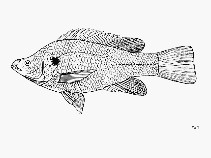http://www.fishbase.org/Summary/speciesSummary.php?genusname=Oreochromis&speciesname=amphimelas ---> http://192.134.151.83/Summary/speciesSummary.php?genusname=Oreochromis&speciesname=amphimelas
http://192.134.151.83/Summary/speciesSummary.php?genusname=Oreochromis&speciesname=amphimelas ---> https://fishbase.mnhn.fr/Summary/speciesSummary.php?genusname=Oreochromis&speciesname=amphimelas
https://fishbase.mnhn.fr/Summary/speciesSummary.php?genusname=Oreochromis&speciesname=amphimelas ---> https://fishbase.mnhn.fr/summary/Oreochromis-amphimelas.html
Oreochromis amphimelas, Manyara tilapia

You can
sponsor
this page
Common name (e.g. trout)
Genus + Species (e.g. Gadus morhua)
-

-
About this page
-
Languages
-
User feedbacks
-
Citation
-
Uploads
-
Related species
-


 Manyara tilapia
Upload your
photos
and
videos
Manyara tilapia
Upload your
photos
and
videos
Pictures
|
Google image
 Oreochromis amphimelas
Oreochromis amphimelas
Picture by
FAO
Teleostei (teleosts) >
Cichliformes
(Cichlids, convict blennies) >
Cichlidae
(Cichlids) > Pseudocrenilabrinae
Etymology:
Oreochromis:
Latin, aurum = gold + Greek, chromis = a fish, perhaps a perch (Ref.
45335
)
.
More on author:
Hilgendorf
.
Environment: milieu / climate zone / depth range / distribution range
Ecology
Freshwater; brackish; benthopelagic. Tropical; 3°N - 5°S
Africa: several shallow saline lakes in central Tanzania (Ref.
118630
), like lakes Manyara, Eyasi, Kitangiri, Singida and Sulungali (Ref.
5166
,
118638
).
Length at first maturity / Size / Weight / Age
Maturity: L
m
?
, range 8 - ? cm
Max length : 28.0 cm SL male/unsexed; (Ref.
4967
)
Dorsal
spines
(total): 12 - 14;
Dorsal
soft rays
(total): 10-12;
Anal
spines
: 3;
Anal
soft rays
: 8 - 11;
Vertebrae
: 30 - 32. Diagnosis: Slender bodied tilapia, characterised by its small eye and slender head profile with terminal mouth (Ref.
118638
); further a narrow preorbital bone and scales of nape, dorsum and belly are very small, the transition from flank to belly scales abrupt, along a curve from base of pectoral fin to vent (Ref.
2
). The upper profile of the head is nearly horizontal and in specimens larger than 130 mm total length there is a steep rise from the occiput to the dorsal fin; the caudal peduncle is long and dorsal and anal fins do not reach its posterior end when adpressed (Ref.
2
). Live territorial males have jet black dorsal fins and are black underneath but are pinkish-red on flank and caudal fin; under stress, such as following capture, the flanks darken and the whole fish appear dark grey, apart from the reddish tailfin; females and non-territorial males grey/silver with pale ventral region (Ref.
118638
).
Found in lakes (Ref.
4967
); small bodied forms are present in Lake Eyasi, Lake Manyara and Lake Sulungali, while large bodied forms can be found in Lake Kitangiri and Lake Singida (Ref.
4967
,
118638
). It is microphagous (Ref.
54840
). A maternal mouthbrooder (Ref.
2
,
118638
). Limited potential as an aquaculture species, it comprises a high proportion of the catch in lakes where it is found (Ref.
118638
). IUCN conservation status is endangered, due to restricted distribution, drought and overfishing (Ref.
118638
). There is some indication of hybridization with
Oreochromis niloticus
and
O. esculentus
(Ref.
118638
).
Life cycle and mating behavior
Maturity
|
Reproduction
|
Spawning
|
Eggs
|
Fecundity
|
Larvae
A maternal mouthbrooder (Ref.
118638
). Breeding cycle of about 7 weeks; there is evidence of biparental mouthbrooding (Ref.
2
).
Trewavas, E.
, 1983. Tilapiine fishes of the genera
Sarotherodon
,
Oreochromis
and
Danakilia
. British Mus. Nat. Hist., London, UK. 583 p. (Ref.
2
)
IUCN Red List Status (Ref.
130435
)
Endangered (EN)
(B1ab(i,iii,v)); Date assessed:
31 January 2006
CITES
Not Evaluated
Not Evaluated
Threat to humans
Harmless
Human uses
FAO - Publication:
search
|
FishSource
|
More information
Countries
FAO areas
Ecosystems
Occurrences
Introductions
Stocks
Ecology
Diet
Food items
Food consumption
Ration
Common names
Synonyms
Metabolism
Predators
Ecotoxicology
Reproduction
Maturity
Spawning
Spawning aggregation
Fecundity
Eggs
Egg development
Age/Size
Growth
Length-weight
Length-length
Length-frequencies
Morphometrics
Morphology
Larvae
Larval dynamics
Recruitment
Abundance
BRUVS
References
Aquaculture
Aquaculture profile
Strains
Genetics
Electrophoreses
Heritability
Diseases
Processing
Nutrients
Mass conversion
Collaborators
Pictures
Stamps, Coins Misc.
Sounds
Ciguatera
Speed
Swim. type
Gill area
Otoliths
Brains
Vision
Tools
E-book
|
Field guide
|
Length-frequency wizard
|
Life-history tool
|
Point map
|
Classification Tree
|
Catch-MSY
|
Special reports
Check for Aquarium maintenance
|
Check for Species Fact Sheets
|
Check for Aquaculture Fact Sheets
Download XML
Summary page
|
Point data
|
Common names
|
Photos
Internet sources
AFORO (otoliths) |
Aquatic Commons
|
BHL
|
Cloffa
|
BOLDSystems
|
Websites from users
|
Check FishWatcher
|
CISTI
|
Catalog of Fishes
:
genus
,
species
|
DiscoverLife
|
ECOTOX
| FAO - Publication:
search
|
Faunafri
| Fishipedia |
Fishtrace
| GenBank:
genome
,
nucleotide
| GloBI |
Google Books
|
Google Scholar
|
Google
| IGFA World Record |
MitoFish
|
Otolith Atlas of Taiwan Fishes
|
PubMed
| Reef Life Survey | Socotra Atlas |
Tree of Life
| Wikipedia:
Go
,
Search
| World Records Freshwater Fishing |
Zoological Record
Estimates based on models
Phylogenetic diversity index (Ref.
82804
): PD
50
= 0.5000 [Uniqueness, from 0.5 = low to 2.0 = high].
Bayesian length-weight: a=0.01905 (0.00827 - 0.04391), b=3.01 (2.82 - 3.20), in cm total length, based on LWR estimates for this (Sub)family-body shape (Ref.
93245
).
Resilience (Ref.
120179
): Medium, minimum population doubling time 1.4 - 4.4 years (Preliminary K or Fecundity.).
Fishing Vulnerability (Ref.
59153
): Low vulnerability (24 of 100).
Nutrients (Ref.
124155
): Calcium = 24.3 [9.2, 128.7] mg/100g; Iron = 1.05 [0.48, 2.47] mg/100g; Protein = 17.3 [15.5, 19.1] %; Omega3 = 0.174 [0.085, 0.377] g/100g; Selenium = 51.6 [24.6, 109.1] μg/100g; VitaminA = 8.8 [1.7, 41.7] μg/100g; Zinc = 1.73 [0.95, 4.05] mg/100g (wet weight);
Back to Search
Random Species
Back to Top
Accessed through:
Not available
FishBase mirror site :
localhost
Page last modified by :
mrius-barile
- 20 July 2016
Fatal error
: Uncaught ArgumentCountError: Too few arguments to function checkEcotox(), 1 passed in /var/www/html/summary/speciessummary.php on line 2304 and exactly 3 expected in /var/www/html/includes/speciessummary.lib.php:2579 Stack trace: #0 /var/www/html/summary/speciessummary.php(2304): checkEcotox() #1 {main} thrown in
/var/www/html/includes/speciessummary.lib.php
on line
2579
|